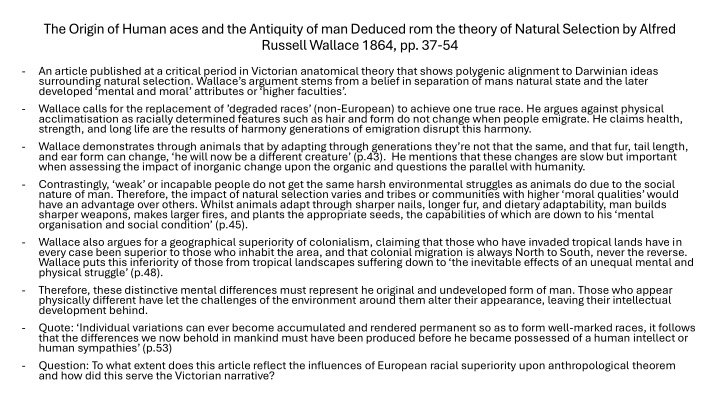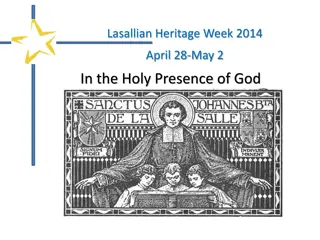
Unpacking Victorian Anthropological Theories on Human Origins
Delve into the historical context of European racial superiority influencing anthropological discourse in the Victorian era. Explore the impact of theories by Wallace and Gall on human races, mental faculties, and cultural biases. Understand how cranial studies and racial classifications shaped narratives of racial hierarchy.
Download Presentation

Please find below an Image/Link to download the presentation.
The content on the website is provided AS IS for your information and personal use only. It may not be sold, licensed, or shared on other websites without obtaining consent from the author. If you encounter any issues during the download, it is possible that the publisher has removed the file from their server.
You are allowed to download the files provided on this website for personal or commercial use, subject to the condition that they are used lawfully. All files are the property of their respective owners.
The content on the website is provided AS IS for your information and personal use only. It may not be sold, licensed, or shared on other websites without obtaining consent from the author.
E N D
Presentation Transcript
The Origin of Human aces and the Antiquity of man Deduced rom the theory of Natural Selection by Alfred Russell Wallace 1864, pp. 37-54 - An article published at a critical period in Victorian anatomical theory that shows polygenic alignment to Darwinian ideas surrounding natural selection. Wallace s argument stems from a belief in separation of mans natural state and the later developed mental and moral attributes or higher faculties . Wallace calls for the replacement of degraded races (non-European) to achieve one true race. He argues against physical acclimatisation as racially determined features such as hair and form do not change when people emigrate. He claims health, strength, and long life are the results of harmony generations of emigration disrupt this harmony. Wallace demonstrates through animals that by adapting through generations they re not that the same, and that fur, tail length, and ear form can change, he will now be a different creature (p.43). He mentions that these changes are slow but important when assessing the impact of inorganic change upon the organic and questions the parallel with humanity. Contrastingly, weak or incapable people do not get the same harsh environmental struggles as animals do due to the social nature of man. Therefore, the impact of natural selection varies and tribes or communities with higher moral qualities would have an advantage over others. Whilst animals adapt through sharper nails, longer fur, and dietary adaptability, man builds sharper weapons, makes larger fires, and plants the appropriate seeds, the capabilities of which are down to his mental organisation and social condition (p.45). Wallace also argues for a geographical superiority of colonialism, claiming that those who have invaded tropical lands have in every case been superior to those who inhabit the area, and that colonial migration is always North to South, never the reverse. Wallace puts this inferiority of those from tropical landscapes suffering down to the inevitable effects of an unequal mental and physical struggle (p.48). Therefore, these distinctive mental differences must represent he original and undeveloped form of man. Those who appear physically different have let the challenges of the environment around them alter their appearance, leaving their intellectual development behind. Quote: Individual variations can ever become accumulated and rendered permanent so as to form well-marked races, it follows that the differences we now behold in mankind must have been produced before he became possessed of a human intellect or human sympathies (p.53) Question: To what extent does this article reflect the influences of European racial superiority upon anthropological theorem and how did this serve the Victorian narrative? - - - - - - -
Historicizing Race by Marius Turda and Maria Sophia Quine 2018, pp. 87-106 The shape of the head in question was believed to be an ancient Etruscan type that showed visible signs of elevated mental faculties p(90). The desire to discover about mental capabilities and origins of the dead sparked fascination in the study of skulls. Certain aspects of skulls were sought after and bragged about, such as crania size. Austrian Franz Joseph Gall studied the development of brain contours to provide insight into the functionality of the brain and how it influenced mental faculties, with cranial bumps attributing to a lack of mental ability and increased physical ability. He also theorized that certain attributes came from specific areas of the brain, combativeness and destructiveness at the back and memory and language at the front. This determination allowed scientists to control human difference through political and religious persuasions. Blumenbach had produced works detailing the recognition of five primary races through skulls, the Caucasian, Mongolian, Aethiopian, American, and the Malayan, distinguished by features such as face width and lip structure, placing attributes of European intellect, beauty, and culture above other structures. These ideas were no longer seen as complex enough to determine racial differences and more quantitative measurements were introduced such as ratios of skull width to length. Many of these methods emerged from areas such as Hungary, Italy, and Germany and were being recognised as potentially unreliable due to racial bias. During this period there were two main strands of anthropology within Europe, the civilized and the uncivilized , preoccupied with racial differentiation, and sub-races were spoken about fundamentally different to Europeans. Efforts to fight this thinking can be seen emerging during this period but most influential anthropologists relied upon the national cephalic index (the measurement of head length and width, e.g longheaded being Northern races and shortheaded Eastern or Western). Some clear efforts to fight racism during this period, e.g the Aborigines Protection Society which campaigned for indigenous rights in Africa and a Quaker leader who founded the first anti-racist journal in Britain, as well as academic rejection of different races. Attempts to abandon the concept of race entirely emerged 1930-40s, with the term race becoming ostracized, but biology was still heavily taxonomical continuing through WWII. Political and communist influences began to impact racial theory, state-sponsored evolutionism (p99). Quote: Physical anthropology was the scientific discipline to suffer most from its association with the idea of race and racial thinking (p.98) Question: How did evolving anthropologic ideology transform the motivation for the study of skulls from derogatory racial segregation to that of anti-racist biology ? - - - - - - -
Stephen J. Gould, Measuring Heads, in The Mismeasure of Man. The idea that Science is rooted in creative interpretation and therefore it should be researched with the understanding that it was calculated with an intended result. Francis Galton (cousin of Darwin) began the measurement trend in the lab at the International Exposition of 1884 where people would pay to go through tests and measurements to understand their bodies and origin. There were a lot of discrepancies in the data collected such as the idea that the brain size did not actually differ person to person and that black men ranked higher than white men in categories such as bone size, however these were discarded as results as they did not fit the intended results. Linking to the above point, there were multiple variables including height weight and age which effected head shape and size however these were discarded if the results fitted into the preconception that Europeans had superior heads. Not only was head size and shape used to rank different races but also rank women within these races concluding that women were always inferior regardless of their race. (intersectionality) Quote- Evolution and quantification formed an unholy alliance p.106 I chose this quote to highlight the turning point of racism from cultural to scientific and how this gave racist beliefs more power as science was considered reliable.
Thomas F. Glick: The Anthropology of Race Across the Darwinian Revolution Darwin did not believe that races were separate species and instead looked at the idea of intelligence as a marker of difference and evolution which led onto his theories of social Darwinism. He supported the abolition of slavery as he did not believe that people were born as this different species to be oppressed. Ideas of recapitulation then came about, the theory that the development of an individual foetus mirrors the evolutionary history of its entire species which to theorists, explained the idea that people were scientifically inferior or superior In the US, they combined Darwinist ideas with that of polygenist ideas by using the theory that intelligence was a marker of difference which was caused by evolution. This enabled scientific racism to take place pleasing both the Darwinist thinkers and the Polygenist thinkers. In Brazil, this racial debate between the two models was crucial after the abolition of slavery and the creation of a republic due to them being a home for many different races which in their view, needed to be constructed into a hierarchy. Miscegenation was a key tool encouraged in Brazil as they believed it would combat mortality by creating mixed- race individuals who would be racially fit to survive in the tropics, however, other countries viewed this concept as a sign of degeneration. -Quote: Social attitudes towards race have, on the whole, been more determining of racial science than any scientific hypothesis p.240. An important thing to recognise that despite all of these efforts to create scientific race , all prejudice were still based off preexisting prejudice.
Scientific Racism and Mid-Victorian Racial Attitudes Douglas Lorimer Emphasises the importance of social and political context in shaping these ideas; Efforts to classify and rank human diversity were shaped by the colonial mission and the abolition of the slave trade, as well as conceptions of class Craniology was practiced and used to strengthen existing racial attitudes it was popular belief that the shape and size of the skull indicated intelligence (also previously believed to indicate temperament) The role of polygenists Robert Knox and James Hunt in scientific racism: In The Races of Men Knox argued that race was the primary determinant of human behavior and intellect, and claimed the "Anglo-Saxon" race was naturally superior and destined to dominate. Hunt, who founded the Anthropological Society of London, was an admirer of Knox s work and shared his racist views, using comparative anatomy to defend them. He believed that people of mixed race were less fertile and propagated the hypersexuality of black people. Anthropologists struggled to create a definitive classification system. To prove their biases they ignored racial mixture, and the variation in African peoples, with Hunt claiming to focus on the true negro of the Congo. Focus shifted to evolutionary explanations for racial differences. Anthropologists such as Russell Wallace applied Darwin s theory of natural selection to ideas of racial classification, undermining polygenist theory. Evolutionary theory however led to other racialised beliefs, for example that indigenous peoples and African peoples would be unable to adapt to civilization and become extinct, and that each race represented a different evolutionary and life stage. the professional gentlemen of the scientific community found pride of race was one way in which to satisfy both their desire for status and their own self-esteem
Constitutions selection: Darwin, race and medicine Seth Suman In the Descent of Man, Darwin connected hereditary traits, race, and disease susceptibility. For example, he correlated darker skin with immunity to certain diseases and used analogy to evidence this, through different levels of immunity to disease among both animals and plants. Most notable is that of the black and white pigs. Medicine and racial theory mutually influenced one another, with medicine not only adopting racial ideas but also reinforcing them both in Victorian society and outside of it. In colonies European doctors deployed racialised medical practices, treating native populations differently under these assumptions and consequently institutionalising race as a determinant of health and access to care. The physician William Ferguson theorised that African skin was responsible for immunity to endemic diseases, most commonly malaria and yellow fever; thick and oily skin was thought to inhibit the effects of the marsh miasmata believed to cause them. Though usually considered to be thin skinned, Europeans with thicker skin and darker hair were also thought to be more resistant to this. At this time disease susceptibility was thought to be just as important as physical and anatomical differences in determining racial classification. Immunity was acknowledged to be a hereditary characteristic, though there was concern that this would be wrongly utilised to argue for polygenism. Darwin attributed the formation of races to sexual selection, proposing that differing ideas of beauty would lead to the amplification of differences over time, as well as discouraging races from mixing. However this theory still did not answer questions of skin colour the primary preoccupation in racial discussion for the Victorians. Race-medicine and race-science, racialized pathologies and racialized anatomies, were often understood as working together. It is our disciplinary and historiographical quirks that keep them apart, not our actors






















